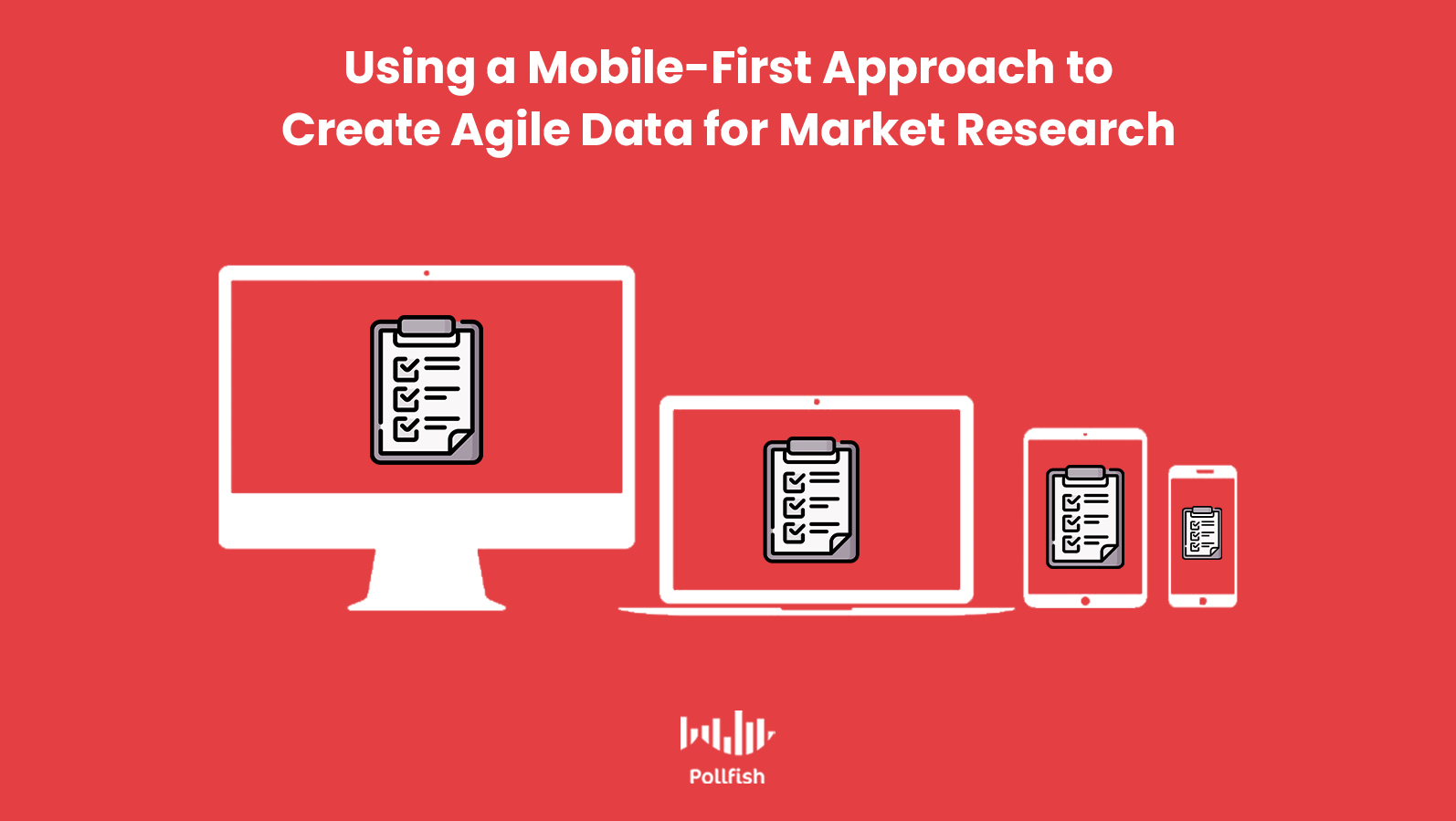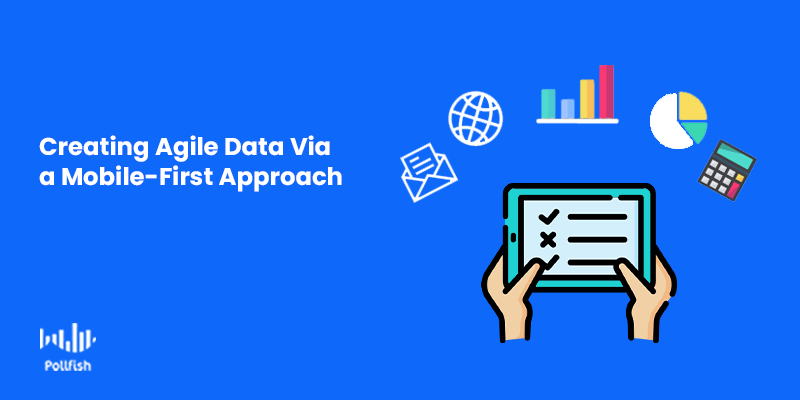How a Mobile-First Approach Creates Agile Data for Market Research

Mobile-first is an invaluable approach in regards to creating agile data — and as you know, you need data, particularly on your customers and market to keep your business intact.
A data-driven workforce is 58% more likely to surpass revenue goals, underpinning the need for businesses to have access to agile data solutions.
In order to reap this kind of data, you must conduct market research, which can be a feat given all the efforts that make up market research techniques come in conflict with the notion of agility.
Implementing the correct solution can remedy this conflict — if it is mobile-first. This article explains how a mobile-first platform yields agile data for market researchers, marketers, analysts and business owners.
Understanding Agile Data
Agile data is a method used by IT professionals, in which they employ a range of strategies for various situations so that they can work in sync effectively on the data component of software systems.
The agile data approach does not rely on one technique; rather there are many that form the backbone for providing data at speed. These include:
- An agile design
- Lean data governance for development teams to foster and maintain high-quality data assets within an overall IT ecology
- Agile data warehousing
- Database testing and more
However, establishing agile data is not solely an internal methodology. In order for it to be of any use to businesses and their employees, it must manifest in the front end, so that its users feel the effect.
In market research, a potent online survey tool can be a vessel for providing agile data. While there are many attempts at fomenting agile data, providing a mobile-first tool is the most powerful of all, in that mobile usage has skyrocketed in recent years.
The Importance of Agile Data
Just as many companies falsely deem themselves to be data-driven, many of them also fall prey to solutions that claim that agile is the norm for them, when in fact, they provide substandard data. Whether it is in regards to its frequency, quality or other capabilities, many solutions fall short of the heavy demands of agile data.
Companies need agile data in that it delivers speed to insights, i.e., data aggregation delivered at speed. But agile data depends on more than speed. It consolidates speedy insights with high-quality data.
As aforementioned, there is no single approach to delivering agile data. IT professionals and UX experts must work hand in hand on a market research platform’s backend to ensure a smooth and efficient data collection, parsing and filtering. This way, the receivers of the data — the market researchers — have a high-quality set of data.

In market research specifically, this is centered on receiving data from the correct respondents. This does not solely refer to the people in your target market, or even the ones you’ve preset in the screening portion. Instead, an agile source of data should quickly disqualify respondents who provide inaccurate or low-quality responses.
There are several ways that an agile platform can eliminate poor responses, such as gibberish answers, one-word answers irrelevant to an open-ended question, untrustworthy responders, such as those using a VPN and more. This is often achieved via technical checks on the market research platform.
However, in the true spirit of agile data, the market research platform must be designed with a mobile-first approach.
Defining Mobile-First
Mobile-first is a kind of design practice in which a digital experience is designed for mobile-first, as its name implies, prior to designing the same experience for other devices, such as desktop or tablet.
Mobile-first prioritizes the development of the mobile experience as a means to optimize it from the jump. As the project progresses, it eventually works towards designing the desktop version of the experience.
A mobile-first approach allows developers to scale up as the project evolves, rather than down, as they would in a desktop-first approach. This ensures that the mobile experience is adequate, rather than an inferior version of a desktop experience.
In a desktop-first design, the mobile experience appears to be a downgraded version of the desktop experience, as many graphics and site elements simply do not fit a mobile experience, given its much smaller screen size. A mobile-first design avoids this subpar effect in the mobile experience, therefore, it is of the utmost importance — and on several accounts.
Positioning a mobile-first methodology is also crucial, given that mobile traffic has consistently exceeded desktop traffic, ever since mobile had first surpassed desktop traffic in 2016. Therefore, mobile use has a far greater impact on reach.
This is critical for attaining agility in market research, as you need your survey sample to be representative of your target market. This is especially necessary if you have a massive target market or intend to survey over a hundred people. It would be nearly impossible to achieve agile data in this regard if not for a mobile-first design.
How Mobile-First Creates Agile Data
A mobile-first design optimizes the experience of mobile users. Since mobile users surpass desktop users, more of them are going to be the targets of an online survey platform.
Thus, a mobile-first design in the online survey platform itself is imperative. Even if a mobile site or app provides a mobile-first experience, your market research is in peril if the platform you use to deploy surveys on that mobile-first mobile property is not itself mobile-first.
This is because a poor experience will turn respondents away, causing survey attrition. Or, the frustration respondents undergo while taking your mobile survey will cause them to provide inaccurate answers or other manifestations of survey bias.
A mobile-first approach avoids these issues along with many others. It also allows an online survey platform to obtain agile data. When a survey for a mobile site or app is developed with a mobile-first approach, it eliminates points of friction. Thus, users are more inclined to take and complete the survey. This efficiency, in turn, produces agile data.

Furthermore, a mobile-first online survey platform removes the sense of inferiority in mobile in comparison to desktop. In this regard, it does not appear as if something in the mobile survey experience is missing. This creates an enhanced experience in a twofold manner:
- It allows the market researcher to set up a mobile survey that includes all of their needs. This includes the capabilities of:
- a wide variety of questions including Matrix questions
- The addition of multimedia elements in appropriate formats
- Multiple selection questions, open and close-ended questions
- Advanced skip logic
- Survey incentives
- It enhances the experience for respondents, thus they are more likely to complete a survey and in a quickened manner.
- Quick responses allow for the survey platform to faster meet all of its quotas, thereby fostering agile data.
A mobile-first approach can also help market researchers save money. This is due to the fact that the performance of many surveys largely depends on survey incentives. Most people do not have time to spare and those that do will want compensation for their survey participation.
Survey incentives make this possible — but they can be costly. In mobile surveys, rather than provide monetary incentives for mobile users, the online survey platform should allow for gaming incentives. The majority of digital users play games on mobile devices (Android, iOS).
As such, a mobile-first approach in an online survey platform would grant in-game perks to gamers who agree to take part in a survey. For example: in order for players to pass to another level, the incentive can be offered as coins/ tokens in the game.
Consequently, mobile players would much rather take part in a mobile survey that rewards them in their games, as opposed to offering them nothing. Thus, their willingness allows market researchers to reach insights sooner, buttressing agile data.
Obtaining Agile Data in Market Research
Many online survey platforms promise agile data but end up underperforming on this front. This is largely due to the absence of several in-platform components that forge agility.
A mobile-first approach in such a platform helps produce an optimized mobile survey experience, which retains respondents and eases the market research process. Market researchers should thereby select their online survey platform wisely.
They should opt for a platform that not only promises agile data, but corroborates it. The Pollfish platform does this via a mobile-first approach along with various quality checks and platform functionalities.
Frequently asked questions
What is the meaning behind mobile-first?
A mobile-first experience means that websites, apps, and other digital properties are specifically designed for the mobile experience, as opposed to fitting all the regular elements used on a desktop. Mobile-first surveys can easily adapt to a mobile screen, as UX designers and web developers ensure that the most important content is displayed and optimized for mobile devices. It is a cost-effective approach that allows the researchers to save money that was spent on conducting countless surveys that may or may not be accurate.
Why is a mobile-first approach important?
A mobile-first approach is cost-effective as it helps researchers save money spent on conducting countless customer surveys that may or may not be accurate.
How can agile data be used in surveys?
Agile data can eliminate low-quality or inaccurate responses from a survey and help in making accurate inferences. They also disqualify participants who use a VPN, give unworthy responses to open-ended questions, or give gibberish answers just for fun, helping to save time organizing data.
What is the link between mobile-first experience and agile data?
A survey optimized for mobile use eliminates all loopholes and points of friction, thus increasing customer satisfaction towards completing the survey. Hence, this efficiency produces agile data.
What is your agile data collection method for companies?
Companies require agile data to deliver speedy and high-quality data. And since there is no one way to approach agile data, our researchers have to work hand-in-hand with UI and UX developers to ensure a smooth data collection method.
Why do companies need agile data?
Companies need agile data in that it delivers speed to insights, i.e., data aggregation delivered quickly. But agile data depends on more than speed. It consolidates speedy insights with high-quality data so that businesses can make effective decisions that reduce organizational risks.
Do you want to distribute your survey? Pollfish offers you access to millions of targeted consumers to get survey responses from $0.95 per complete. Launch your survey today.
